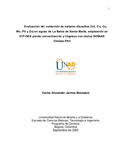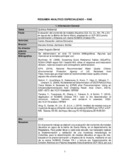Mostrar el registro sencillo del ítem
Evaluación del contenido de metales disueltos (Cd, Co, Cu, Mn, Pb y Zn) en aguas de La Bahía de Santa Marta, empleando un ICP-OES previa concentración y limpieza con resina NOBIAS Chelate-PA1
| dc.contributor.advisor | Zambrano Bothía, Marcela Zambrano | |
| dc.contributor.advisor | Bernal, Cesar Augusto | |
| dc.coverage.spatial | cead_-_santa Marta | spa |
| dc.creator | Jaimes Monsalve, Carlos Alexander | |
| dc.date.accessioned | 2020-09-12T14:28:44Z | |
| dc.date.available | 2020-09-12T14:28:44Z | |
| dc.date.created | 2020-09-10 | |
| dc.identifier.uri | https://repository.unad.edu.co/handle/10596/36221 | |
| dc.description | El documento contiene lista de figuras, diagramas, tablas, ecuaciones, apéndice y anexos | |
| dc.description.abstract | En el presente trabajo se elaboró una evaluación del contenido de metales disueltos en agua de la bahía de Santa Marta, en el departamento de Magdalena, la cual es el depósito final de los residuos generados por la actividad antrópica de la zona. Para poder llevar a cabo este estudio, fue necesario realizar la implementación de una novedosa metodología en Colombia, para la determinación de metales disueltos en agua de mar, basada en la preconcentración y limpieza de la muestra, mediante el uso de la resina NOBIAS Chelate PA-1 y lectura por Espectrometría de Emisión Atómica con Plasma Acoplado Inductivamente (ICP-OES, por sus siglas en inglés). Inicialmente se realizaron pruebas para determinación de Plata (Ag), Aluminio (Al), Bario (Ba), Cadmio (Cd), Cobalto (Co), Cromo (Cr), Cobre (Cu), Hierro (Fe), Manganeso (Mn), Níquel (Ni), Plomo (Pb), Vanadio (V) y Zinc (Zn) disueltos en blancos fortificados y adicionados conocidos en muestras de mar. Posteriormente se llevaron a cabo ensayos adicionales experimentales de suficientes figuras de mérito a partir de estadística descriptiva (promedio, SD, % RSD, % error, % recuperación) y paramétrica (coeficiente de correlación y significancia) que permitieron validar Cd, Co, Cu, Mn, Pb y Zn disueltos en agua de mar, con una precisión expresada como RSD < 15.0 % y veracidad expresada en términos de recuperación entre (60 - 110) %. Se realizó recolección de muestras el día 10 de octubre de 2019 (época de lluvia), en nueve puntos, que fueron elegidos debido a las descargas ocasionadas por el río Manzanares, escorrentías urbanas y el emisario submarino, así como actividades de turismo, transporte y portuarias. Las muestras fueron planificadas, recolectadas, preservadas, ingresadas y analizadas en el Laboratorio de Calidad Ambiental Marina (LABCAM) del Instituto de Investigaciones Marinas y Costeras “José Benito Vives de Andréis” (INVEMAR), siguiendo los procedimientos establecidos. A partir de la metodología implementada y validada en el presente trabajo se determinaron concentraciones por debajo del límite de cuantificación del método de Cd, Co, Cu, Pb y Zn disueltos en las muestras de agua recolectadas en la bahía de Santa Marta. En contraste, Mn fue detectado en todos los puntos y los valores fueron reportados con incertidumbre expandida al 95 % de confianza usando un factor de cobertura de 2, y se presentó una máxima concentración de 10.7 ± 0.80 µg Mn/L en el punto Playa Batallón, el cual es influenciado por la desembocadura del Río Manzanares. Finalmente, la evaluación de la calidad del agua de la zona de estudio, se realizó por comparación de los resultados con las tablas de referencia para efectos agudos o crónicos sobre la biota marina (SQUIRTs) de la Administración Nacional de EUA para los Océanos y la Atmósfera (NOAA) (Buchman, 2008) y los criterios de calidad del agua recomendados por la Agencia de Protección Ambiental de Estados Unidos (EPA, 2016) donde se encontró que los metales disueltos analizados no superaron los límites de referencia establecidos. Los resultados obtenidos fueron comparados con los informes técnicos de diagnóstico y evaluación de la calidad de aguas marinas y costeras realizados por INVEMAR, publicados entre 2016 a 2020, donde se encontró que en las épocas de lluvia, incluido este estudio Cd, Cu, Pb y Zn no superaron los límites de referencia (Buchman, 2008) y (EPA, 2016). Sin embargo, en época seca de 2015 la concentración obtenida de Zinc (101 µg Zn/L) superó el límite para efectos agudos (90.0 µg Zn/L) y en 2018 la concentración obtenida de Plomo (10.9 µg Pb/L) superó el límite para efectos crónicos (8.10 µg Pb/L) (Buchman, 2008); por otra parte, Co y Mn no han sido reportados por INVEMAR. Adicionalmente los resultados de este estudio, fueron comparados con resultados de cinco estudios similares elaborados en zonas costeras internacionales ubicadas en Irán e India. | spa |
| dc.format | ||
| dc.title | Evaluación del contenido de metales disueltos (Cd, Co, Cu, Mn, Pb y Zn) en aguas de La Bahía de Santa Marta, empleando un ICP-OES previa concentración y limpieza con resina NOBIAS Chelate-PA1 | spa |
| dc.type | Proyecto aplicado | |
| dc.subject.keywords | Contaminación del agua - Bahía de Santa Marta | spa |
| dc.subject.keywords | Contaminación por metales | spa |
| dc.subject.keywords | Toxicidad | spa |
| dc.description.abstractenglish | In the present work, an evaluation of the content of dissolved metals in the water of the Santa Marta bay, in the Magdalena department, was elaborated, which is the final deposit of the residues generated by the anthropic activity of the area. In order to carry out this study, it was necessary to implement a new methodology in Colombia, for the determination of dissolved metals in seawater, based on preconcentration and cleaning of the sample, through the use of NOBIAS Chelate PA resin. -1 and read by Inductively Coupled Plasma Atomic Emission Spectrometry (ICP-OES). Initially tests were carried out to determine Silver (Ag), Aluminum (Al), Barium (Ba), Cadmium (Cd), Cobalt (Co), Chromium (Cr), Copper (Cu), Iron (Fe), Manganese (Mn ), Nickel (Ni), Lead (Pb), Vanadium (V) and Zinc (Zn) dissolved in fortified targets and known additions in sea samples. Subsequently, additional experimental tests of sufficient figures of merit were carried out from descriptive statistics (average, SD,% RSD,% error,% recovery), and significance tests that allowed to validate Cd, Co, Cu, Mn, Pb and Zn dissolved in sea water, with a precision expressed as RSD <15.0% and truthfulness expressed in terms of recovery between (60 - 110)%. Samples were collected on October 10, 2019 (rainy season), in nine points, which were chosen due to the discharges caused by the Manzanares River, urban runoff and the underwater outfall, as well as tourism, transport and ports. The samples were planned, collected, preserved, entered and analyzed in the Marine Environmental Quality Laboratory (LABCAM) of the Institute for Marine and Coastal Research "José Benito Vives de Andréis" (INVEMAR), following the established procedures. From the methodology implemented and validated in this work, concentrations below the limit of quantification of the method of Cd, Co, Cu, Pb and Zn dissolved in the water samples collected in the bay of Santa Marta were determined. In contrast, Mn was detected at all points and the values were reported with expanded uncertainty to 95% confidence using a coverage factor of 2, and a maximum concentration of 10.7 ± 0.80 µg Mn / L was presented at the Playa Batallón point. , which is influenced by the mouth of the Manzanares River. Finally, the evaluation of the water quality of the study area was carried out by comparing the results with the reference tables for acute or chronic effects on marine biota (SQUIRTs) of the US National Administration for Oceans and Atmosphere (NOAA) (Buchman, 2008) and the water quality criteria recommended by the United States Environmental Protection Agency (EPA, 2016) where it was found that the dissolved metals analyzed did not exceed the established reference limits. The results obtained were compared with the technical reports of diagnosis and evaluation of the quality of marine and coastal waters carried out by INVEMAR, published between 2016 and 2020, where it was found that in the rainy seasons, including this study Cd, Cu, Pb and Zn did not exceed the reference limits (Buchman, 2008) and (EPA, 2016). However, in the dry season of 2015, the concentration obtained for Zinc (101 µg Zn / L) exceeded the limit for acute effects (90.0 µg Zn / L) and in 2018 the concentration obtained for Lead (10.9 µg Pb / L) exceeded the limit for chronic effects (8.10 µg Pb / L) (Buchman, 2008); on the other hand, Co and Mn have not been reported by INVEMAR. Additionally, the results of this study were compared with the results of five similar studies carried out in international coastal zones located in Iran and India. | spa |
| dc.subject.category | Química Ambiental | spa |
















